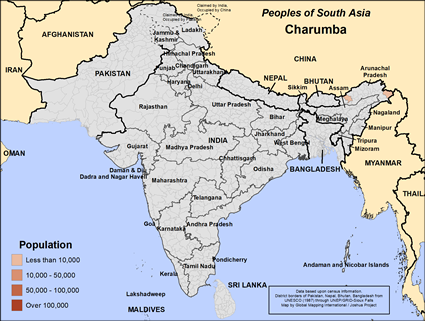Charumba in India

Photo Source:
Copyrighted © 2025
Operation China, Asia Harvest All rights reserved. Used with permission |

Map Source:
People Group data: Omid. Map geography: UNESCO / GMI. Map Design: Joshua Project
|
| People Name: | Charumba |
| Country: | India |
| 10/40 Window: | Yes |
| Population: | 1,000 |
| World Population: | 1,800 |
| Primary Language: | Zakhring |
| Primary Religion: | Buddhism |
| Christian Adherents: | 7.73 % |
| Evangelicals: | 0.00 % |
| Scripture: | Unspecified |
| Ministry Resources: | No |
| Jesus Film: | No |
| Audio Recordings: | Yes |
| People Cluster: | South Asia Tribal - other |
| Affinity Bloc: | South Asian Peoples |
| Progress Level: |
|
Introduction / History
Much confusion surrounds the tiny, little-known Zakhring tribe of northeast India. They inhabit the hilly terrain and the banks of the Lohit River in the Walong and Kibithoo area (Hayuliang Subdivision) of the Lohit District in Arunachal Pradesh.
Regardless of their small size and the multiplicity of names, the Indian government has granted official status to this group as a Scheduled Tribe.
Scholar Dutta Choudhury says the Charumba arrived from the north (Tibet) in two waves of migration—the first in the late 1800s and the second wave a few years later in the early 1900s. These two separate migrations may explain why such a small group of a few hundred people speak two distinct dialects, which the Ethnologue labels Lower Zyphe and Upper Zyphe. When they first arrived in the Lohit District they 'had to face bitter opposition from the Mishmis. However, Charumba migrants overcame the opposition and settled in and around Walong. '
What Are Their Lives Like?
The Charumba enjoy close relationships with the Tibetans and Monpa, and intermarriage with these groups is encouraged. Many Tibetan refugees live nearby. Charumba art reflects their origins in Tibet and their faith in Tibetan Buddhism. The Charumba 'paint scrolls and murals, make wooden images of Buddha and produce some hand painted wooden objects and masks.'
What Are Their Beliefs?
Along with Buddhism, the Charumba practice the shamanistic Bon religion. Charumba Buddhism is tinged with beliefs in animism and shamanism. Their shamanistic priest is known as kahu who practices witchcraft. He is often called in to cure a person suffering from a disease. Besides Lord Buddha and the Bodhistatvas, the Zakhrings also have a community deity or village deity known as Yong or the deity of the hills. Thus, each village has a separate Yong. '
What Are Their Needs?
The Charumba are isolated in a small area that has needs outside help for economic development. They lack adequate medical and educational facilities.
Prayer Points
Pray for the economic and medical needs of the Charumba people to be met.
Pray for his kingdom to come and his will to be done among the Charumba people.
Pray for a movement of Charumba households to study the Bible and accept the blessings of Christ.
Pray for a spiritual hunger that will drive the Charumba people to the loving arms of Jesus.
Pray for workers who are filled with the fruit and the power of the Holy Spirit to go to the Charumba people.